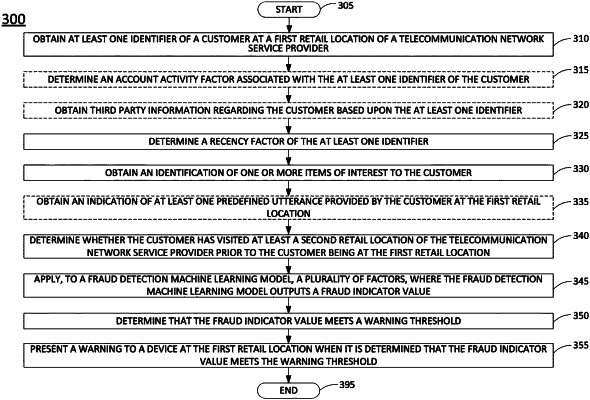| CPC G06N 20/20 (2019.01) [G06F 18/214 (2023.01); G06F 18/24323 (2023.01); G06N 20/00 (2019.01); G06Q 20/4016 (2013.01); G06Q 40/03 (2023.01)] | 20 Claims |

|
1. A method comprising:
training, by a processing system including at least one processor, a fraud detection machine learning model implemented by the processing system, wherein the fraud detection machine learning model comprises a plurality of independent factors and a dependent variable comprising a fraud indicator, wherein the fraud detection machine learning model is trained with a training data set comprising sets of the independent factors for a plurality of completed transactions between a plurality of customers and a communication network service provider, wherein each of the sets of the independent factors is labeled with an indicator of one of: fraud or no fraud;
obtaining, by the processing system, at least one identifier of a customer at a first retail location of the communication network service provider;
determining, by the processing system, a recency factor of the at least one identifier;
obtaining, by the processing system, an identification of one or more items of interest to the customer;
determining, by the processing system, whether the customer has visited at least a second retail location of the communication network service provider within a first predefined time period prior to the customer being at the first retail location;
applying, by the processing system, to the fraud detection machine learning model implemented by the processing system, a plurality of factors comprising: a number of the one or more items of interest, a total value of the one or more items of interest, a factor associated with whether the customer has visited at least the second retail location within the first predefined time period, and the recency factor of the at least one identifier of the customer, wherein the fraud detection machine learning model outputs a fraud indicator value of the fraud indicator;
determining, by the processing system, that the fraud indicator value meets a warning threshold;
presenting, by the processing system, a warning to a personnel device at the first retail location when it is determined that the fraud indicator value meets the warning threshold; and
retraining, by the processing system, the fraud detection machine learning model when an accuracy of the fraud detection machine learning model declines below a threshold accuracy.
|